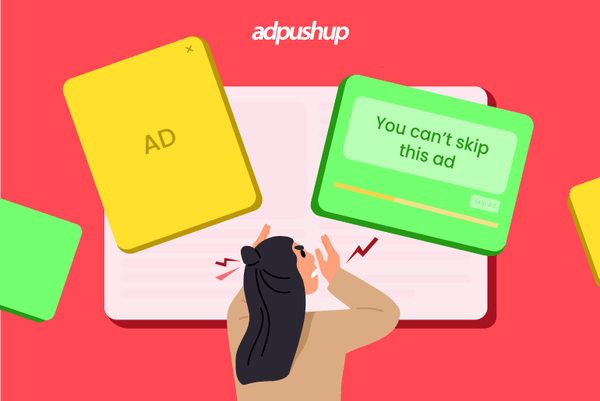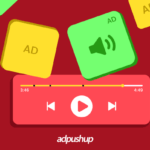Discover the hidden menace of intrusive advertising and its impact on publishers in this revealing exploration of the digital advertising landscape,
As a publisher who is looking to generate revenue from content through advertisements, it’s crucial to be mindful of how we present ads. It’s a reality that users become irritated when they’re overwhelmed with ads, so we must exercise caution in our ad placement strategy.
In fact, according to a report by Backlinko, the percentage of people who use ad blockers is staggering; almost 42.7% of all internet users.
Thus, publishers must use ads that are not invasive to the user’s online experience. They should be respectful of the user’s time and attention by remaining in the background where they can be easily ignored.
As these ads get more and more sophisticated, they are widespread among many publishers. But at what cost? Let’s find out.
What Exactly is Intrusive Advertising?
Intrusive advertising is the practice of forcing unwanted and unnecessary advertisements on users.
These advertisements pop up out of nowhere, cover part or all of the web page, flash annoyingly, launch new tabs, or start playing videos or music at inopportune times.
This will upset consumers and lead them to lose interest in your offer and brand, dooming your campaign to failure from the get-go.
Types of Intrusive Advertising
Popup Ads
Popup ads are widely disliked, with the highest disapproval rating. A significant 81% of internet users have closed a web page due to popup ads, primarily because they dislike being compelled to close these ads.
Additionally, 89% find popup ads that require clicking the “X” to remove them extremely frustrating.
Pop Ads, short for “pop-up advertisements,” are a form of online advertising that appear as separate windows or dialogue boxes that “pop up” over the content of a webpage the user is viewing.
These ads can vary in size, format, and content but are typically designed to capture the user’s attention and convey a marketing message.
Prestitial Video Ads
Prestitial video ads, which are online video ads that play before other video content loads are also highly disliked by internet users.
This format is widely disliked in advertising due to the perception of forcing viewers to watch the ad.
Prestitial video ads are a form of online advertising that appears before the main content of a webpage or within a mobile app. These ads typically consist of short video clips or animations and are displayed while the user is waiting for the desired content to load.
However, while they can be effective in terms of visibility, prestitial video ads are also considered intrusive by some users. They can disrupt the user experience by delaying access to the desired content, especially if the ad is not skippable.
Mobile Ads
People find mobile ads annoying likely due to the fact that the smaller screen size makes them seem much more obtrusive.
Interstitial adverts, which are interactive full-screen ads that cover the interface of their host app or site, are one kind of obtrusive mobile advertising.
They are invasive because of their complete covering of the screen, even though they often occur during transition moments or pauses between content (such as between game levels).
Autoplaying Video Ads
According to a recent poll by eMarketer, autoplay video commercials with sound are the most aggravating sort of internet ad, with two-thirds of respondents agreeing.
Autoplay video ads are a digital advertising format where videos start playing automatically when a web page loads or when a user scrolls to a specific point on a webpage.
These ads are often accompanied by sound and are designed to capture the viewer’s attention immediately.
While they can be effective in conveying a message, autoplaying video ads are considered intrusive by many users.
They disrupt the user’s browsing experience, especially if the audio starts unexpectedly, and they can consume data and slow down page loading times.
Page Takeovers
Page takeovers are a form of intrusive advertising that can significantly disrupt a user’s online experience. In this advertising tactic, an ad or promotional content completely takes over a webpage, temporarily replacing or obscuring the original content the user was trying to access.
These takeovers often manifest as large, attention-grabbing ads that overlay the page, forcing users to interact with them or close them before they can proceed with their intended activity.
This can be particularly frustrating for users, as it can create an abrupt interruption in their browsing experience.
Interstitial Ads
Interstitial ads are a type of online advertising format that occupies the entire screen of a user’s device, typically appearing between web page transitions or as a full-page overlay.
Unlike traditional banner or display ads that appear within the content of a webpage, interstitial ads create a temporary interruption, often before the user can access the desired content.
These ads are known for their high visibility and can contain various forms of multimedia, including images, videos, and interactive elements.
Why Non Intrusive Advertising is Better Than Intrusive Advertising?
There are several ways in which intrusive advertising may hurt publishers’ bottom lines.
Your website visitors may get turned off by the barrage of unnecessary information that is common in invasive marketing campaigns, leading them to stop interacting with advertising and the publisher’s content entirely.
Non-intrusive marketing, on the other hand, has a better chance of attracting the attention of its intended audience because of its precision and individualization.
However, non-intrusive advertising that takes into account users’ choices and provides material that is relevant to the site’s context tends to generate more revenue than its intrusive counterparts.
Ads that don’t interrupt users’ experience are more likely to earn the confidence of readers and keep them as subscribers, which is good for publishers in the long run.
Is There Any Other Option Besides Intrusive Advertising?
Here are some other advertising ways that companies may use to successfully increase brand recognition while also satisfying their customers:
Display Ads
Email marketing and online push notifications are two examples of marketing automation technologies that may gather audience data to help with targeted campaign development and the delivery of non-intrusive display advertisements.
For instance, social media display advertising may target people who are likely already familiar with your brand and product based on their demographic and interest information.
How Display Ads Are a Better Option Compared to Intrusive Advertising?
- Less Disruptive: Display ads are less intrusive and disruptive to the user’s browsing experience compared to intrusive advertising like pop-ups and interstitials.
- Enhanced User Engagement: Well-crafted display ads can engage users with compelling visuals and relevant content.
- Targeted Relevance: Display ads can be precisely targeted based on user data, ensuring relevance and increasing engagement.
- Ad Blocker Friendliness: They are less likely to trigger ad blockers, ensuring wider reach.
- Positive Brand Image: Display ads contribute positively to a brand’s image when executed thoughtfully, unlike intrusive ads that may harm it.
- Compliance: Display ads are easier to manage within privacy regulations and industry standards.
- User Retention: They contribute to user retention and longer-term engagement by offering a more user-friendly experience.
- Effective Tracking: Display ads can be effectively tracked and measured, enabling data-driven optimizations for better campaign performance.
Paid Search Engine Ads
When done well, paid search advertising may be a type of inbound marketing that doesn’t interrupt users’ experiences. Users do intent-based searches to start the conversation, rather than marketers reaching out to them.
Your business may reach people who are actively looking for a solution like the one you provide by using paid search advertising that is tailored to specific search queries. In comparison, you won’t be talking to random people on the internet.
Why Paid Search Engine Ads?
- Relevance: Paid search ads are displayed to users actively searching for specific products or information, ensuring higher relevance and engagement.
- User Intent: These ads align with user intent, as they appear based on specific keywords or queries, making them less disruptive.
- Targeting: Paid search ads allow precise ad targeting based on demographics, location, and user behavior, reducing annoyance and improving ROI.
- Non-Intrusive: They appear alongside organic search results, rather than interrupting user experiences, resulting in a more user-friendly approach.
- Performance Tracking: Advertisers can track performance metrics closely, optimizing campaigns for better results.
- Ad Blocker Resilience: Paid search ads are less likely to be blocked by ad blockers, ensuring broader reach.
Native Ads
Native ads seamlessly blend with the appearance of the platform, minimizing disruption compared to other ad types. They can be found on the open web alongside relevant content.
Sponsored articles on Adweek, for instance, harmonize with the site’s look and format.
Social media advertising largely follows a native approach. For instance, Facebook’s in-feed image and out-stream video ads seamlessly integrate with the content, especially retargeting ads.
The sole distinction is the “Sponsored” label, which doesn’t disrupt the user experience.
What Makes Native Ads Non-Disruptive?
- Seamless Integration: Native ads blend seamlessly with the content and design of the platform, making them less obtrusive and more in line with the user experience.
- Relevance: Native ads are typically relevant to the content surrounding them, reducing the likelihood of user irritation caused by irrelevant content.
- User Engagement: They tend to engage users more effectively because they are contextually relevant and fit the overall content flow.
- Lower Intrusiveness: Unlike intrusive ads that interrupt the user experience, native ads aim to enhance it by providing value within the existing content.
- Reduced Ad-Blocking: Users are less inclined to use ad blockers when native ads are used, preserving ad visibility and revenue for publishers.
The Bottom Line
When intrusive advertising bombards people, they often stop paying attention altogether—an effect known as advertisement fatigue. Worse yet, if ads come off as annoying or irrelevant, individuals might take active steps to disable or block them.
The key to overcoming this challenge lies in presenting your brand in an engaging, informative manner. Rather than bombarding your audience with numerous ads, strive to create content that resonates. Quality and relevance trump quantity when it comes to establishing meaningful connections with your audience.
To truly connect and reap long-term benefits from your advertising endeavors, prioritize crafting content that captivates and adds value. This approach fosters a stronger bond with your audience compared to simply inundating them with ads.
Frequently Asked Questions: Intrusive Advertising
A pop-up ad is an example of intrusive advertising since it displays without the user’s permission and blocks access to the page’s content until the user closes the ad.
Invasive marketing describes promotional strategies that are too forceful or intrusive, and which often violate users’ wishes and personal space. Unwanted and unwanted communication includes things like spam emails, telemarketing calls, and unwanted adverts.
Non-intrusive marketing involves marketing strategies and ads that respect the user’s experience and preferences. Examples include native advertising that seamlessly integrates with content, well-targeted ads, and opt-in email subscriptions where users willingly choose to receive promotional content.

Deepak has a keen eye for detail and a deep understanding of the ad tech landscape. Whether it’s through in-depth articles, thought-provoking insights, or compelling storytelling, he’s dedicated to helping people navigate the complex world of ad tech with the simplicity of his words.




![CTV vs OTT Advertising: Which one is Right Pick for Publishers? + [6 Bonus Strategies] Ott vs Ctv](png/featured-image-270x180.png)


